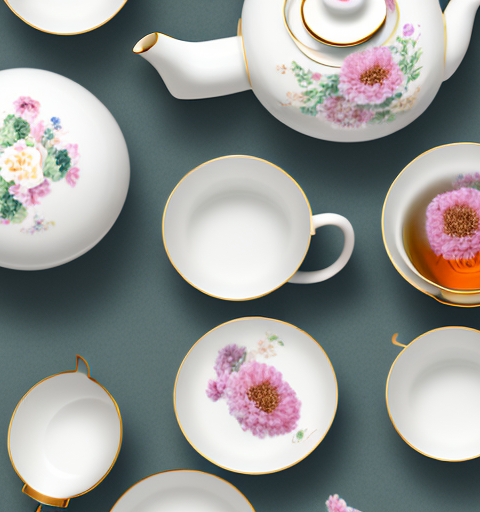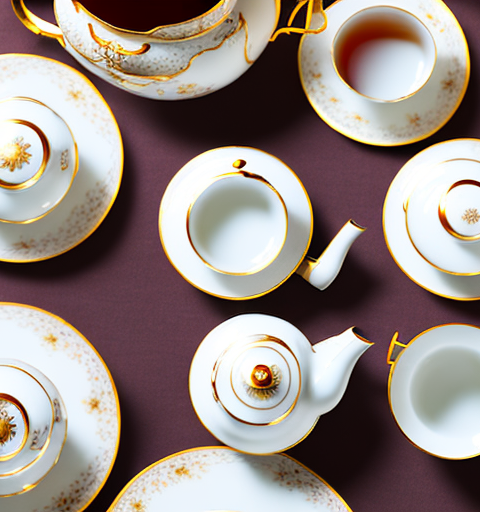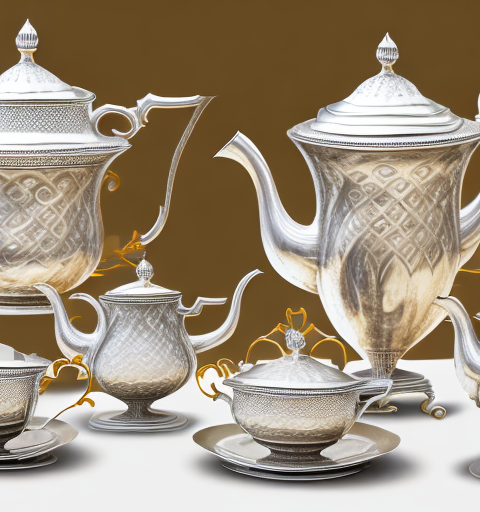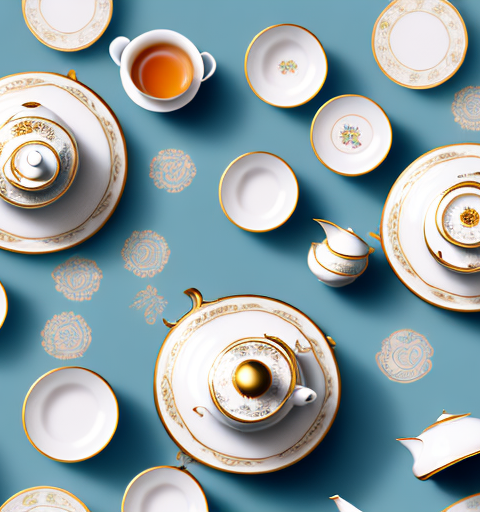Understanding the Basics of Pu-erh Tea
Pu-erh tea is a unique type of fermented tea that originates from the Yunnan province in China. Known for its rich and distinct flavor profile, pu-erh tea has gained popularity among tea enthusiasts worldwide. Before diving into whether a ceramic teapot is suitable for brewing pu-erh tea, it’s important to have a grasp of the tea itself.
Pu-erh tea can be categorized into two main types: raw pu-erh and ripe pu-erh. Raw pu-erh undergoes a natural aging process, allowing it to develop a complex flavor over time. On the other hand, ripe pu-erh undergoes an accelerated fermentation process, resulting in a mellow and earthy taste. Both types can benefit from using the right teapot, ensuring optimal brewing and flavor extraction.
In addition to its unique flavor profile, pu-erh tea is also known for its potential health benefits. It is believed to aid in digestion, promote weight loss, and reduce cholesterol levels. Pu-erh tea is also rich in antioxidants, which can help protect the body against free radicals and oxidative stress. However, it’s important to note that more research is needed to fully understand the extent of these health benefits.
Exploring Different Teapot Materials for Brewing Pu-erh Tea
When it comes to choosing a teapot for brewing pu-erh tea, the material of the teapot plays a crucial role. Different materials can affect the flavor, heat retention, and brewing process of the tea. Ceramic teapots are a popular choice among tea enthusiasts due to their versatility and ability to retain heat effectively.
Other materials commonly used for pu-erh tea brewing include clay, glass, and cast iron. Clay teapots, such as Yixing teapots, are highly regarded for their ability to enhance the tea’s flavor. Glass teapots offer a visually appealing brewing experience, allowing you to witness the tea leaves unfurl and infuse. Cast iron teapots are known for their excellent heat retention, making them suitable for longer brewing sessions.
Another material that is gaining popularity for brewing pu-erh tea is stainless steel. Stainless steel teapots are known for their durability and ability to retain heat. They are also easy to clean and maintain, making them a convenient choice for tea enthusiasts. Additionally, stainless steel teapots do not impart any flavors or odors to the tea, allowing the true taste of the pu-erh tea to shine through.
Advantages and Disadvantages of Using a Ceramic Teapot for Pu-erh Tea
Using a ceramic teapot for brewing pu-erh tea has its advantages and disadvantages. One of the main advantages is that ceramic is a non-reactive material, meaning it won’t affect the taste of the tea. Ceramic teapots also have excellent heat retention, allowing the tea to steep evenly and ensuring a consistent flavor.
On the other hand, ceramic teapots may not retain heat as well as other materials such as cast iron or clay. This can result in faster cooling of the tea, especially during longer brewing sessions. However, this can be mitigated by using a teapot warmer or preheating the teapot before brewing.
Another advantage of using a ceramic teapot for pu-erh tea is its versatility. Ceramic teapots come in a variety of shapes and sizes, allowing you to choose one that suits your personal preferences and brewing style. Whether you prefer a small teapot for individual servings or a larger one for sharing with friends, there is a ceramic teapot available to meet your needs.
Factors to Consider When Using a Ceramic Teapot for Pu-erh Tea Brewing
When using a ceramic teapot for brewing pu-erh tea, there are several factors to consider for optimal results. Firstly, the size of the teapot should be suitable for the quantity of tea you want to brew. A larger teapot may result in the tea becoming diluted, while a smaller teapot can lead to a stronger and more concentrated brew.
Additionally, the shape of the teapot can also affect the brewing process. Teapots with wider openings promote faster heat dissipation, while teapots with narrower openings retain heat better. Consider the desired brewing time and flavor intensity when choosing a teapot shape.
Another important factor to consider when using a ceramic teapot for pu-erh tea brewing is the material of the teapot. Ceramic teapots are known for their ability to retain heat, which can be beneficial for maintaining the optimal brewing temperature. However, it is important to choose a high-quality ceramic teapot that is free from any glazes or coatings that may affect the taste of the tea.
Furthermore, the design and craftsmanship of the teapot can also impact the brewing experience. Look for a teapot with a well-fitted lid to prevent heat loss and ensure a proper seal. Additionally, a teapot with a built-in strainer or infuser can make the brewing process more convenient by allowing you to easily separate the tea leaves from the brewed liquid.
How Does the Material of a Teapot Affect the Flavor of Pu-erh Tea?
The material of the teapot can significantly influence the flavor profile of pu-erh tea. Ceramic teapots, with their non-reactive nature, allow the tea’s natural flavors to shine through without any interference. Pu-erh tea brewed in a ceramic teapot tends to have a smooth and well-rounded taste.
Compared to other materials, such as clay teapots, ceramic teapots may not enhance the tea’s flavor as intensely. However, this can be an advantage if you prefer a more subtle and balanced flavor. Experimenting with different teapot materials can offer unique tasting experiences and help you discover your preferred flavor profile.
On the other hand, clay teapots have a porous nature that can absorb some of the tea’s flavors and aromas. This can result in a more pronounced and complex taste profile for pu-erh tea. The clay material can also retain heat well, which can contribute to a longer-lasting and warmer brew. However, it’s important to note that the type of clay used in the teapot can also impact the flavor. Yixing clay, for example, is highly regarded for its ability to enhance the natural flavors of pu-erh tea.
The Importance of Choosing the Right Teapot for Brewing Pu-erh Tea
Choosing the right teapot for brewing pu-erh tea is essential to unlocking its full flavor potential. While a ceramic teapot can be a suitable choice, it’s important to consider your personal preferences and brewing style. Some tea enthusiasts prefer the flavor-enhancing properties of clay teapots, while others enjoy the simplicity and versatility of ceramic teapots.
Ultimately, the right teapot is one that complements your brewing ritual and allows you to enjoy pu-erh tea in a way that satisfies your taste buds. Whether it is ceramic, clay, glass, or any other material, the teapot should enhance your tea experience and bring out the best flavors.
When selecting a teapot for brewing pu-erh tea, it’s also worth considering the size and shape of the teapot. The size of the teapot should be proportional to the amount of tea you plan to brew. A larger teapot may be suitable for brewing multiple cups of tea, while a smaller teapot is ideal for individual servings.
The shape of the teapot can also impact the brewing process. Teapots with a wide, flat base and a short spout are often preferred for pu-erh tea, as they allow for better heat distribution and control during brewing. Additionally, a teapot with a tight-fitting lid helps to retain heat and preserve the aroma of the tea.
Step-by-Step Guide: Brewing Pu-erh Tea in a Ceramic Teapot
Now, let’s explore the step-by-step process of brewing pu-erh tea in a ceramic teapot:
- Start by preheating the ceramic teapot by rinsing it with hot water. This will ensure that the teapot retains heat during the brewing process.
- Measure the desired amount of pu-erh tea leaves and place them into the teapot. A general guideline is 1 teaspoon of tea leaves per cup of water.
- Heat water to the appropriate temperature for pu-erh tea. For raw pu-erh, water temperature around 203°F (95°C) is recommended, while ripe pu-erh is best brewed with water around 195°F (90°C).
- Pour the hot water over the tea leaves in the teapot and let it steep for the recommended time. Typically, raw pu-erh requires shorter steeping, around 30 seconds to 1 minute, while ripe pu-erh benefits from longer steeping, around 2 to 3 minutes.
- After the steeping time is complete, pour the brewed tea into cups or a separate pitcher, leaving the tea leaves in the teapot. This helps prevent over-extraction and bitterness.
- Enjoy your freshly brewed pu-erh tea, savoring its unique flavors and aromas.
Here are a few additional tips to enhance your pu-erh tea brewing experience:
- Consider using filtered or spring water for brewing pu-erh tea. The quality of water can greatly impact the taste and aroma of the tea.
- Experiment with different steeping times and water temperatures to find your preferred flavor profile. Some tea enthusiasts enjoy shorter steeping times for a lighter and more delicate taste, while others prefer longer steeping times for a stronger and bolder flavor.
Tips and Tricks for Using a Ceramic Teapot to Brew Pu-erh Tea
Here are some tips and tricks to enhance your pu-erh tea brewing experience using a ceramic teapot:
- Experiment with different water temperatures and steeping times to find your preferred flavor profile.
- Consider using a tea strainer or tea filter to prevent tea leaves from entering your cup while pouring.
- Keep your ceramic teapot clean by rinsing it with hot water after each use. Avoid using soap, as it may leave a residue that affects the tea’s flavor.
- If using a larger teapot, adjust the tea-to-water ratio accordingly to maintain the desired strength of the brewed tea.
- Consider using high-quality pu-erh tea leaves for the best flavor and aroma.
Another tip for using a ceramic teapot to brew pu-erh tea is to preheat the teapot before adding the tea leaves. This helps to maintain the optimal brewing temperature and ensures that the tea leaves steep evenly. Simply pour hot water into the teapot and let it sit for a minute or two before discarding the water and adding the tea leaves.
Exploring Other Suitable Teapots for Brewing Pu-erh Tea
While ceramic teapots offer a great brewing experience for pu-erh tea, it’s worth exploring other suitable teapots as well. Clay teapots, such as Yixing teapots, are highly regarded for their ability to enhance the tea’s flavor and aroma due to their porous nature. Glass teapots, on the other hand, provide a visually appealing brewing experience.
Each teapot material offers unique advantages and can bring out different aspects of pu-erh tea. Exploring different teapot materials can add variety to your tea sessions and help you appreciate the diverse characteristics of pu-erh tea.
Another option to consider when brewing pu-erh tea is a cast iron teapot. Cast iron teapots are known for their excellent heat retention, which helps to keep the tea hot for a longer period of time. This can be particularly beneficial when enjoying multiple cups of tea or when brewing tea for a larger group of people.
In addition to the material of the teapot, the shape and size of the teapot can also impact the brewing experience. Teapots with a wider base and shorter spout, such as gaiwans or traditional Chinese teapots, allow for better heat distribution and control during the brewing process. This can result in a more balanced and flavorful cup of pu-erh tea.
Comparing Ceramic Teapots with Other Materials for Pu-erh Tea Brewing
Comparing ceramic teapots with other materials for pu-erh tea brewing can provide valuable insights into their strengths and weaknesses.
Ceramic teapots, as mentioned earlier, are non-reactive and excellent at heat retention. They offer a versatile and well-rounded brewing experience. Clay teapots, particularly Yixing teapots, have a reputation for enhancing the tea’s flavor and aroma due to their porous nature. Glass teapots, while fragile, allow for a visually captivating brewing experience, showcasing the unfurling of the tea leaves.
Each material has its own unique properties, and the choice ultimately depends on personal preferences and the desired tea drinking experience.
Stainless steel teapots are another popular option for pu-erh tea brewing. They are known for their durability and ability to retain heat. Stainless steel teapots are also non-reactive, ensuring that the tea’s flavor remains unaffected. Additionally, they are easy to clean and maintain, making them a convenient choice for tea enthusiasts.
Bamboo teapots, although less common, offer a unique brewing experience. The natural bamboo material adds a subtle earthy flavor to the tea, enhancing its overall taste. Bamboo teapots are also lightweight and eco-friendly, making them a sustainable choice for tea lovers who prioritize environmental consciousness.
Maintaining and Cleaning Your Ceramic Teapot for Optimal Pu-erh Tea Flavor
To maintain optimal pu-erh tea flavor when using a ceramic teapot, regular cleaning and proper care are crucial.
After each use, rinse the ceramic teapot with hot water to remove any residue and tea stains. Avoid using soap or harsh detergents, as they can leave behind unwanted aromas and affect the tea’s flavor. Allow the teapot to air dry completely before storing it.
Occasionally, you may notice a build-up of mineral deposits inside the teapot. To remove these, fill the teapot with a mixture of warm water and white vinegar. Let it sit for a few hours, then rinse thoroughly with hot water. This will help maintain the teapot’s cleanliness and prevent any unwanted flavors from transferring to your brewed tea.
In addition to regular cleaning, it is also important to handle your ceramic teapot with care to ensure its longevity. Avoid placing it directly on a stove or open flame, as extreme heat can cause the teapot to crack or break. Instead, use a separate kettle or heat the water in a different container before pouring it into the teapot.
Common Mistakes to Avoid When Using a Ceramic Teapot for Pu-erh Tea
When using a ceramic teapot for brewing pu-erh tea, there are a few common mistakes to avoid:
- Avoid using excessive force when cleaning your teapot, as this can cause damage to the ceramic material. Gentle cleaning is sufficient to maintain its cleanliness.
- Do not leave pu-erh tea leaves in the teapot for an extended period, as this may result in over-extraction and bitterness.
- Ensure the teapot is adequately preheated before pouring hot water to prevent sudden temperature changes that could affect the brewing process.
- Avoid using the teapot to serve other types of tea with overpowering flavors, as the ceramic material may retain these aromas and transfer them to future brews.
By avoiding these common mistakes, you can enjoy a delightful and flavorsome cup of pu-erh tea brewed in your ceramic teapot.
Another common mistake to avoid when using a ceramic teapot for pu-erh tea is using water that is too hot. Pu-erh tea is best brewed at a lower temperature, around 195°F (90°C), to prevent the leaves from becoming scorched and releasing bitter flavors.
It is also important to properly season your ceramic teapot before using it for pu-erh tea. Seasoning involves rinsing the teapot with hot water and allowing it to absorb some of the tea’s flavors. This helps to enhance the taste and aroma of the pu-erh tea when brewed in the teapot.
Conclusion
In conclusion, a ceramic teapot can indeed be used for brewing pu-erh tea. With its non-reactive nature and excellent heat retention, it provides a versatile brewing experience that allows the tea’s natural flavors to shine through. However, the choice of teapot material ultimately depends on personal preferences, desired flavor profiles, and the overall tea brewing experience you seek. Whether you choose ceramic, clay, glass, or any other material, the key to a successful pu-erh tea brewing experience lies in understanding the tea, selecting the right teapot, and following proper brewing techniques.






